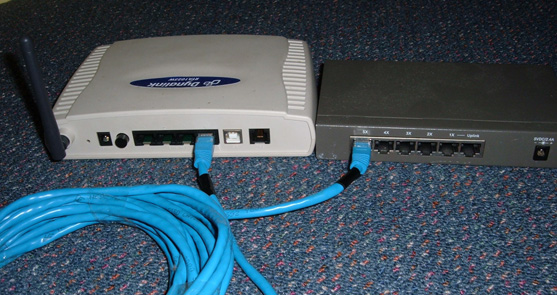Basic Network guide |
|
Basic wired setup guide
We'll start with a cabled setup.To use this kind of connection, you will need to have the following:
A modem, router, or switch with a free Ethernet port, a suitable Ethernet cable (100Mb or gigabit certified) and an Ethernet LAN card in your PC.
Attached are some images of my router, and a 5 port ethernet switch.

The front view.

Rear view. Note the router has an aerial for 55Mb Wi-fi, 4x ethernet ports, and a USB connection.
Also note the blue ethernet cable linking the two.
Assuming your network is already functional, connecting to your PC should be as simple as plugging the cable in to your network card, waiting a minute and then you're good to go.
Different Ethernet devices can connect together. This is called up-linking. In my home router setup, I have the following hardware:
- Wireless router
- Gigabit switch
- 3 Wired PCs
- One wireless laptop
- Some good hints:
- Never connect more than one cable between devices - it won't make it faster, and may slow down or 'break' the network. (Example: If your PC has two network cards, connecting two cables to your router will not make anything faster.)
- Some motherboards come with dual network cards, and support a feature called NIC teaming. This feature is explained in more detail in the 'Advanced networking' page of this article.
- Shorter cable lengths are better. While an extra meter wont make much of a difference, an extra ten metres of wasted length could cause problems with electrical interference. Try and get cables as short as possible.
- Cables are a trip hazard - if they have to run more than a meter or so, try running them along walls, above door frames, and so on. Professionally installed cables are a good idea, but if you can make it safer yourself, do so.
- Cat5e is the standard for modern 100Mb cables; Cat6 is the preferred type for gigabit. However cat5e cables will easily handle gigabit speeds for short distances, so there is no need for the more expensive Cat6 unless you're running it more than 20 Meters or so.
Jul 2nd, 2025 02:15 CDT
change timezone
Latest GPU Drivers
New Forum Posts
- What would you buy? (36)
- Best motherboards for XP gaming (21)
- Help me choose the right PSU , Cooler Master vs Seasonic (62)
- The Official Thermal Interface Material thread (1762)
- TPU Server Move Completed (9)
- My PSU died.. (2)
- With the 4 temperature detection sockets of the Corsair Commander PRO hub, can I skip the ICUE software and directly monitor it with AIDA64? (8)
- What's your latest tech purchase? (24185)
- What phone you use as your daily driver? And, a discussion of them. (1750)
- Is this Card Fake RX580 (1)
Popular Reviews
- ASUS ROG Crosshair X870E Extreme Review
- Crucial T710 2 TB Review - Record-Breaking Gen 5
- Sapphire Radeon RX 9060 XT Pulse OC 16 GB Review - An Excellent Choice
- AVerMedia CamStream 4K Review
- Upcoming Hardware Launches 2025 (Updated May 2025)
- AMD Ryzen 7 9800X3D Review - The Best Gaming Processor
- Lexar NQ780 4 TB Review
- Sapphire Radeon RX 9070 XT Nitro+ Review - Beating NVIDIA
- AMD Ryzen 9 9950X3D Review - Great for Gaming and Productivity
- NVIDIA GeForce RTX 5060 8 GB Review
TPU on YouTube
Controversial News Posts
- Intel's Core Ultra 7 265K and 265KF CPUs Dip Below $250 (288)
- NVIDIA Grabs Market Share, AMD Loses Ground, and Intel Disappears in Latest dGPU Update (209)
- Some Intel Nova Lake CPUs Rumored to Challenge AMD's 3D V-Cache in Desktop Gaming (140)
- NVIDIA GeForce RTX 5080 SUPER Could Feature 24 GB Memory, Increased Power Limits (112)
- Microsoft Partners with AMD for Next-gen Xbox Hardware (105)
- NVIDIA Launches GeForce RTX 5050 for Desktops and Laptops, Starts at $249 (105)
- Intel "Nova Lake‑S" Series: Seven SKUs, Up to 52 Cores and 150 W TDP (100)
- NVIDIA DLSS Transformer Cuts VRAM Usage by 20% (91)